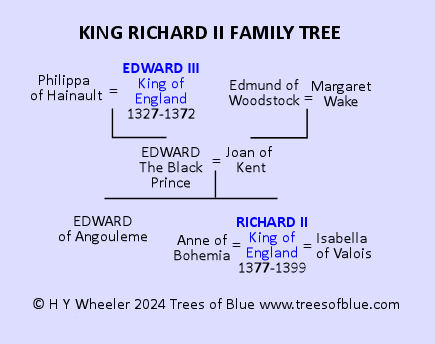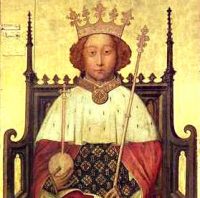King Richard II (1367-1400) was a member of the House of Plantagenet. He succeeded his grandfather, King Edward III in 1377 aged 10 years. His uncle, John of Gaunt acted as regent during his minority. He was deposed in 1399 by his cousin Henry Bolingbroke.
Contents
King Richard II Family Tree Image
King Richard II Family Tree in Table Form
King Richard II Short Biography
King Richard II Family Tree Image showing:
grandparents, parents, sibling, wives

King Richard II Family Tree in Table Form showing:
grandparents, parents, sibling, wives
GRANDPARENTS
Paternal Grandfather – Edward III, King of England – (1284 – 1327)
Paternal Grandmother – Philippa of Hainault – (1313 – 1369)
Maternal Grandfather – Edmund of Woodstock – (1301 – 1330)
Maternal Grandmother – Margaret Wake – (1297 – 1345)
PARENTS
Father – Edward the Black Prince – (1330 – 1376)
Mother – Joan of Kent – (1326 – 1385)
SIBLINGS
Edward of Angouleme – (1365 – 1370)
MARRIED
Anne of Bohemia – (1366 – 1394)
Isabella of Valois – (1389 – 1409)
CHILDREN
No children
GRANDCHILDREN
No grandchildren
King Richard II Short Biography
Early Years
King Richard II was born on 6th January 1367 to Edward, the Black Prince, eldest son of King Edward III, and Joan of Kent at Woodstock Palace. He was known as Henry Bolingbroke after his place of birth. Richard was the couple’s second son, his brother Edward had been born in 1364. At the time of his birth, his father was heir to the throne.
In 1371, Richard’s elder brother, Edward died and Richard became second in line to the throne after his father.
Prince Richard was likely educated as befitted a future King of England. He would have been schooled in academic subjects as well as languages, horsemanship and military skills.
On 8th June 1376, Richard’s father, Edward the Black Prince, died. Richard, who was aged 9 years became heir to the throne.
King of England
King Edward III died on 21st June 1377 and ten year-old Richard became King of England.
King Richard II was crowned at Westminster Abbey on 16th July 1377. Because he was a minor, his uncle, John of Gaunt, acted as regent for the young king.
Poll Tax
At the time of Richard’s accession, England was at war with France and a new tax called a poll tax was introduced to finance the war. The new tax was very unpopular because everyone, rich and poor, had to pay the same rate.
In 1381 the rate of the poll tax was raised to 1 shilling (equivalent to around £40 in 2022). Encouraged by travelling priest John Ball, peasants in Kent revolted against the tax and marched on London. When John Ball was imprisoned, Wat Tyler took over as leader and freed the priest.
At the same time peasants in Essex, led by Jack Strawe had refused to pay the tax and were also marching to London.
When the two groups met in London in June 1381, the mood turned ugly and they became violent. They stormed the Tower of London and murdered those taking refuge there including the Archbishop of Canterbury and the Lord Treasurer.
Richard met the protestors at Smithfield where Wat Tyler was killed. Richard offered a pardon if the protestors dispersed. However, the pardon was soon revoked and the uprisings were supressed by force. John Ball was hung drawn and quartered.
The Poll Tax was quietly dropped soon afterwards.
Marriages
On 20th January 1382, King Richard II married Anne of Bohemia, daughter of Charles IV, Holy Roman Emperor. The couple were close but had no children. Anne died on 7th June 1394, possibly from the plague, at Sheen Palace. Richard was very upset by her death and had Sheen Palace demolished.
On 4th November 1396, Richard married for the second time. As part of a peace between England and France Richard agreed to marry Isabella, the six year old daughter of King Charles VI of France.
Ruler of England
Richard began to take control of the country around 1383. He began to upset members of the nobility when he appointed his favourites to key positions.
In 1387, a group of noblemen, known as the Appellants, accused a number of Richard’s closest friends of treason. Richard’s cousin, Henry Bolingbroke, was one of the Appellants. King Richard II refused to listen and sent a force to defeat the Appellants. The two groups met at Radcot Bridge on 19th December and the Royalists were defeated.
After being defeated at Radcot Bridge, Richard had to accept the verdict of Parliament that his friends were guilty of treason. Chief Justice Tresilian and Simon Burley were executed, while others were imprisoned.
Parliament also introduced legislation that set controls on the privileges enjoyed by the King.
In 1389, Richard announced that he was going to assume sole rule without advisors. Although he appeared to be ruling according to Parliament’s wishes, he was secretly organising a force to defeat his opponents and return to ruling how he wished.
Later Rule
By 1397 King Richard II had returned to using the system for his own ends. He ordered the execution of his opponents – Thomas Duke of Gloucester and Richard Earl of Arundel – and the exile of the Earl of Warwick and the Archbishop of Canterbury.
The following year Richard banished Henry Bolingbroke and the Duke of Norfolk after they had chosen to settle a quarrel using trial by battle.
On 3rd February 1399 John of Gaunt, father of Henry Bolingbroke, died. Due to Bolingbroke’s exile, Richard seized John of Gaunt’s titles and gave them to his friends.
Bolingbroke was furious and, supported by Henry Percy and Thomas Arundel invaded England, captured the king, imprisoned him in Pontefract Castle and forced him to abdicate.
After forcing Richard II to abdicate, Henry Bolingbroke took the throne as King Henry IV on 30th September 1399.
In the Spring of 1400 it was announced that King Richard II had died. There is speculation as to whether he starved himself or was forcibly starved to death, or was murdered another way.
Published Apr 6 2022 – Updated – Dec 5 2024
Harvard Reference for King Richard II Family Tree:
Heather Y Wheeler. (2022 – 2025). King Richard II Family Tree & Biography (1367-1400). Available: https://www.treesofblue.com/king-richard-ii-family-tree-1367-1400. Last accessed April 15th, 2025

